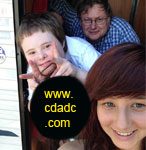

Low Muscle Tone and hypotonia – diagnosis and treatment
Please note that this article on hyptonia is one of several we are putting together, our personal experience and understanding with hypotonia etc can found there.
What Is Hypotonia? An Overview.
Hypotonia is defined as a condition of abnormally low muscle tone far beyond what even the weakest of healthy people exhibit.
A lack of muscle tone and a lack of muscle strength are not the same thing.
A muscle can be as strong as a bodybuilder’s and still have low tone.
In the medical sense, muscle tone refers to the ability of the muscle to respond to a stretch.
If you surprise a healthy person by stretching out one of their limbs, the appropriate muscle will automatically contract to prevent injury. This is because the motor nerve control acts subconsciously to keep us from harming ourselves.
By contrast, a hypotonic’s motor nerve control is weak at best, so they don’t fully contract the muscle before relaxing. They are also incapable of maintaining a contracted muscle for any length of time, so the muscles can never realize their full potential.
Hypotonia is not a disease in and of itself, but rather an indicator of a variety of disorders.
These disorders affect either motor nerve control or the muscles themselves.
Hypotonia only affects muscles, it does not affect intellect or mental capacity in any way.
While diagnosing hypotonia is usually reasonably simple, finding out the cause can be both difficult and time consuming.
The long term effects of hypotonia vary wildly depending on both cause and severity.
The most common form of hypotonia treatment is ongoing physical rehabilitation to help the patient compensate for the weakness.
Because of the nature of muscle strength, early intervention is the most successful at dealing with hypotonia and allowing the person to have a decent quality of life.
Hypotonia in more detail
While hypotonia used to be diagnosed as benign congenital hypotonia, that term is now outdated in the medical community after many of the congential causes were discovered and classified as disorders in their own right.
Hypotonia is now seen as a symptom, not a disease unto itself.
Causes of hypotonia
There are a large number of causes for hypotonia.
Some causes of hypotonia are genetic in nature while others are caused by infections, autoimmune disorders, metabolic disorders, and neurological injury.
Each of these causes has other symptoms associated with it, so differential diagnosis is usually how the underlying cause of hypotonia is discovered.
Hypotonia is most often diagnosed in infants and children, though there are a small number of disorders such as hypothyroidism and some bacterial infections that can cause hypotonia to start during adulthood.
Symptoms of Hypotonia
No matter the cause, hypotonia exhibits a number of common symptoms.
Hypotonia often shows in children and infants as floppy, limp limbs along with extremely flexible and movable joints.
Because of the large number of muscles and ligaments controlling the mouth and jaw, people with hypotonia often have speech difficulties along with drooling.
Reflexes are poor because of lack of muscle tone and brain/muscle communication.
Poor attention spans, lack of motivation, frequent support leaning and rounded shoulder posture are also common signs and symptoms of hypotonia, as is chronic shallow breathing due to problems with diaphragm stimulation.
Other hypotonia symptoms such as constipation depend on the age of the person, what muscles are affected and how severe the condition is.
In children the first symptoms of hypotonia are referred to as “floppy infant syndrome”.
Floppy Infant Syndrome
The baby feels like a rag doll, as though they’re about to slip out of one’s hands.
They can’t control their head movements at all, they can often extend their ligaments past normal lengths although they can’t maintain a flexed ligament and they often have problems feeding as their mouth muscles don’t develop well.
Their caregivers must be careful to pick them up correctly, as a hypotonic child picked up under the arms will slip right out of an adult’s hands.
In contrast to a healthy infant, hypotonic babies will usually make no visible attempt whatsoever to hold their bodies level if held horizontally.
Hypotonia’s effect on Development
As hypotonic children get older, they reach physical developmental milestones later than their peers, especially in the realms of speech and motor control.
The two categories of motor control development are gross motor control and fine motor control, both of which are usually affected. Gross motor control skills include large movements such as picking up the head, rolling over, and sitting up. Fine motor control skills refer to the ability to grasp an item, transfer an item from one hand to another, follow an object with the eyes, and self-feeding.
Cure and Treatment for Hypotonia
Most of the causes of hypotonia currently have no known cure.
Every case of hypotonia is unique due to interaction with and other symptoms caused by the underlying problem.
Occasionally, muscle tone improves over time with appropriate physical therapy.
In addition, even if the muscle tone itself does not improve the person can learn how to cope with and overcome his or her symptoms.
However, some forms of hypotonia linked to progressive degenerative diseases can be fatal, which is why proper diagnosis of the underlying cause is important no matter how difficult it might be.
In the case of degenerative hypotonia caused by cerebellar dysfunction or motor neuron diseases, physical aid and therapy might even be limited to mechanical breathing and feeding assistance along with manual stimulation of muscles and joints to prevent atrophy as much as possible and isolation measures to try and prevent opportunistic infections such as tuberculosis or pneumonia.
Threatment for hypotonia normally involves massive amounts of stimulation in order to improve muscle function and control as much as possible.
Of course, it also involves exercise of the muscles in question, but more important is giving the person a deep conscious awareness of how their muscles work.
When successful, this conscious knowledge serves as a substitute for the reflexive control they are incapable of.
Of course, a practiced and knowledgeable therapist is necessary in order to prevent injury during therapy sessions and to give the hypotonic tools to use in everyday life.
Early intervention and treatment for hypotonia is so important because while this awareness is conscious instead of reflexive, it must be very deeply ingrained in order to provide as many benefits as possible.
The vast majority of children with hypotonia can be helped through physical and occupational therapy along with early sensory stimulation exercises.
In case studies of adults with very mild hypotonic disabilities, researchers found that 78% of them had severe difficulty and delay in regard to childhood development milestones, which means that a child’s condition during the toddler years is not predictive of his or her possible quality of life as an adult.
By getting the right treatment, support and education at the right time, hypotonia can largely be overcome.
Research and main write by Loni L. Ice, quality control, editing and additional writing by D. S. Urquhart.

Leave a Reply
You must be logged in to post a comment.